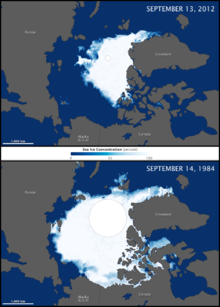
Back التغير المناخي في القطب الشمالي Arabic Změna klimatu v Arktidě Czech Folgen der globalen Erwärmung in der Arktis German Deshielo ártico Spanish Klima aldaketa Artikoan Basque تغییرات اقلیمی در قطب شمال Persian Arktisen alueen kutistuminen Finnish Changement climatique dans l'Arctique French Կլիմայական փոփոխությունները Արկտիկայում Armenian Perubahan iklim di Arktik ID


Major environmental issues caused by contemporary climate change in the Arctic region range from the well-known, such as the loss of sea ice or melting of the Greenland ice sheet, to more obscure, but deeply significant issues, such as permafrost thaw,[1] as well as related social consequences for locals and the geopolitical ramifications of these changes.[2] The Arctic is likely to be especially affected by climate change because of the high projected rate of regional warming and associated impacts.[3] Temperature projections for the Arctic region were assessed in 2007:[4] These suggested already averaged warming of about 2 °C to 9 °C by the year 2100. The range reflects different projections made by different climate models, run with different forcing scenarios. Radiative forcing is a measure of the effect of natural and human activities on the climate. Different forcing scenarios reflect things such as different projections of future human greenhouse gas emissions.
These effects are wide-ranging and can be seen in many Arctic systems, from fauna and flora to territorial claims.[2] According to a July 2022 article in Geophysical Research Letters, temperatures in the Arctic region are rising four times as fast as elsewhere on Earth,[5]: 1 [6] leading to these effects worsening year on year and causing significant concern. The changing Arctic has global repercussions, perhaps via ocean circulation changes[7] or arctic amplification.[8]
- ^ Kessler, Louise (May 2017). "Estimating the Economic Impact of the Permafrost Carbon Feedback". Climate Change Economics. 08 (2): 1750008. doi:10.1142/s2010007817500087. ISSN 2010-0078.
- ^ a b Arvelo, Juan (2011). An Under-Ice Arctic Geophysical Exploration Sonar System Concept To Resolve International Territorial Claims. Proceedings of Meetings on Acoustics. Vol. 12. Acoustical Society of America. p. 070002. doi:10.1121/1.3626896.
- ^ Intergovernmental Panel on Climate Change (2007). "3.3.3 Especially affected systems, sectors and regions". Synthesis report (PDF). Climate Change 2007: Synthesis Report. A Contribution of Working Groups I, II, and III to the Fourth Assessment Report of the Intergovernmental Panel on Climate Change (IPCC). Geneva, Switzerland: IPCC. Retrieved 15 September 2011.[permanent dead link]
- ^ Anisimov, O.A. (2007). "15.3.2 Projected atmospheric changes". In Parry, M.L.; et al. (eds.). Chapter 15: Polar Regions (Arctic and Antarctic). Climate change 2007: impacts, adaptation and vulnerability: contribution of Working Group II to the fourth assessment report of the Intergovernmental Panel on Climate Change (IPCC). Cambridge University Press (CUP): Cambridge, UK: Print version: CUP. This version: IPCC website. ISBN 978-0-521-88010-7. Retrieved 15 September 2011.
- ^ Chylek, Petr; Folland, Chris; Klett, James D.; Wang, Muyin; Hengartner, Nick; Lesins, Glen; Dubey, Manvendra K. (16 July 2022). "Annual Mean Arctic Amplification 1970–2020: Observed and Simulated by CMIP6 Climate Models". Geophysical Research Letters. 49 (13). Bibcode:2022GeoRL..4999371C. doi:10.1029/2022GL099371. ISSN 0094-8276. S2CID 250097858. via Wikipedia Library and EBSCOhost
- ^ "Arctic temperatures are increasing four times faster than global warming". Los Alamos National Laboratory. Retrieved 18 July 2022.
- ^ "Atlantic Ocean circulation shows "exceptional" slowdown". Physics Today. 2015. doi:10.1063/pt.5.028751. ISSN 1945-0699.
- ^ Francis, Jennifer A.; Vavrus, Stephen J. (17 March 2012). "Evidence linking Arctic amplification to extreme weather in mid-latitudes". Geophysical Research Letters. 39 (6): n/a. Bibcode:2012GeoRL..39.6801F. doi:10.1029/2012gl051000. ISSN 0094-8276. S2CID 15383119.
© MMXXIII Rich X Search. We shall prevail. All rights reserved. Rich X Search